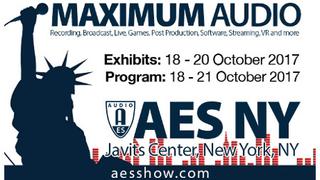New Tech Abounds, Scope Broadens at AES 2017
NEW YORK—The 143rd Audio Engineering Society International Convention and Exposition promises more synergies of people, ideas and technologies than any AES event in history. That's important to consider, as the modern audio engineer will likely touch down in fields of broadcast and content streaming, networked audio, live sound, recording and music production, audio for games, films and multimedia content—and who knows what else—just within the next year.

AES attendees will continue to find the most carefully curated new technologies on the exposition floor, yet a broader sense of purpose will be emphasized through the Javits Convention center. Co-located with the debuting NAB Show New York event, AES allows members and attendees with an Exhibits-Plus or All Access AES registration the full scope of what it means to both literally and figuratively network in pro audio today.
Nothing more effectively exemplifies the necessity of these AES Convention synergies than the AoIP revolution within professional audio. More often paired with the video content, the workflow of audio engineering is increasingly distributed via Ethernet and manipulated via GUI, or touch, devices. And despite the stalwart creative uses of analog signal processing, most historically analog products have been effectively emulated in digital tools, or plug-ins, today, thus processes living in an at-the-source captured digital world offer a variety of positive benefits. So the network controllability of, for example, a digital microphone opens up a world of workflow (and cashflow) benefits. Such concepts are just the tip of the iceberg; one that is melting due to the hot brain trust to be found at gatherings like AES NYC 2017.
“Networked audio affords end users and installers so many benefits that it's easy to see why [many] customers are demanding it,” note Audio-Technica Engineer Ben Cochran, who has worked on his company's AoIP/Dante-ready microphone initiative—a “disruptive tech” success, like USB microphones—from the beginning. “Installs are cheaper and easier when using Cat5 over traditional copper cabling. Giving customers the ability to remotely-control their devices over the same cable connection that's providing audio means less confusion in routing, channel identification, and establishing presets between different setups or shows. Customers are always excited by the ability to plug a host of microphones into a network switch and configure them without worry that something was plugged in to the wrong channel, or has the wrong setting. Once the audio is on the network, it can go anywhere and easily be reconfigured. For that reason, we believe that networked audio is the future of connectivity for professional media products.”
Get the TV Tech Newsletter
The professional video industry's #1 source for news, trends and product and tech information. Sign up below.
